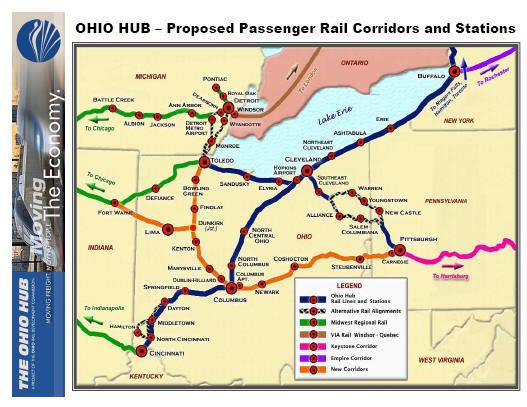Author's posts
Oct 26 2009
Sunday Train: Leveraging Pittsburgh / Cleveland for Canton/Akron / UPDATED
Burning the Midnight Oil for Living Energy Independence
crossposted from ProgressiveBlue, also available in Orange
 One of the stories that came out into the press this week was the pledge by the US Department of Transport to look into extending the designated HSR corridors to include Pittsburgh/Cleveland.
One of the stories that came out into the press this week was the pledge by the US Department of Transport to look into extending the designated HSR corridors to include Pittsburgh/Cleveland.
This would extend the Cleveland/Chicago route via northern Indiana and connect with the Triple-C route at Cleveland (both currently competing for HSR Stimulus funding). This is a 145 mile alignment that would offer a 2:10 Express trip between these two cities as a 110mph corridor, for a 67mph route speed – and faster, of course, if later upgraded to a 125mph Regional HSR corridor.
The focus today is not, however, High Speed Rail – it is conventional rail. The focus is on how to take this alignment that hit the top northeast corner of Akron’s Summit County and leverage it into effective rail service for the Canton-Akron area.
Oct 23 2009
Action Hours Against Rupert the Pirate: Week One
Burning the Midnight Oil for Breaking the Silicon Cage
crossposted from My Left Wing
 Rupert Murdoch operates and profits from a big pirate support base, and we – I and anyone who joins with me – are going to go after him, in an ongoing “name and shame” operation, until he agrees to close down the pirate support operations at his base.
Rupert Murdoch operates and profits from a big pirate support base, and we – I and anyone who joins with me – are going to go after him, in an ongoing “name and shame” operation, until he agrees to close down the pirate support operations at his base.
Act on Friday, 4pm Eastern, 1pm Pacific, and 10pm Eastern, 7pm Pacific.
Or, to make a different analogy, Rupert Murdoch owns own of those pawn shops that “just happen” to end up with stolen goods in their possession. That is, some pawn shops in run-down areas of town are just fence. Some are legalized loan sharks that work hard at avoiding being fences. And some respect the letter of the law but, well, if they somehow end up with stolen goods anyway, well, waddyagonnado? “Dese people are here, no respect for private property”.
Few bootleg anime streaming sites would be able to keep operating if they had to pay the cost of streaming the media themselves. Fortunately for them, Rupert is happy to host their bootleg anime on MySpace servers. As long as its not NewsCorp copyright rights, NewsCorp is happy to do the minimum required by the law (I am sure it is just a coincidence that the when ordinary users link to the bootleg media at MySpace, that draws traffic and brings revenue to MySpace).
But who watches out for the little guys?
Oct 22 2009
Rupert Murdoch is the Biggest Pirate of the US Anime Market
Burning the Midnight Oil for Breaking the Silicon Cage
Crossposted from My Left Wing, also available in Orange
 When I wrote Can the Teaspoon Model stand up to Bloodsucker Streaming Sites?, it was clear that one reason the bloodsucker leech anime streaming sites are able to offer their “free anime” because they don’t pay streaming costs either. They rely on pointing their users to places that host the streams.
When I wrote Can the Teaspoon Model stand up to Bloodsucker Streaming Sites?, it was clear that one reason the bloodsucker leech anime streaming sites are able to offer their “free anime” because they don’t pay streaming costs either. They rely on pointing their users to places that host the streams.
They are, in other words, an aggregator. People that know how to look and where to look collect the information, and they put a shell around it to make it convenient to the user. They live off a trickle of net advertisements and donations – and of course, nothing ever gets back to the animators, voice actors and actresses, producers, directors who actually create the work.
And if the anime was unavailable in this country, they could argue they are “growing the market”. But of course, an increasing amount of this media is available for legitimate free streaming, supported by a range of internet ads, streaming ads, and subscription models – which does feed income back to the industry that creates these collaborate works.
But the real problem is the hosts for the streams. Without the free hosting of bootleg streams, these leech bloodsucker sites could never afford to offer, as one of these sites boasts, “503 series, 7,657 anime episodes”. Its the ability to point to free streams of bootleg copies provided by someone else that allows the bloodsucker leech sites to spoil the market for legitimate streaming sites.
Oct 22 2009
Confronting Rupert Murdoch on his Copyright Hypocrisy
 Over the last little while, I have been essaying about the New Media Economy, from What Can Newspaper Reporting Learn from Yuricon? through Can the Hero Model Save the Publishing Industry? to Can the Teaspoon Model stand up to Bloodsucker Streaming Sites?.
Over the last little while, I have been essaying about the New Media Economy, from What Can Newspaper Reporting Learn from Yuricon? through Can the Hero Model Save the Publishing Industry? to Can the Teaspoon Model stand up to Bloodsucker Streaming Sites?.
Now, Rupert Murdoch, NewsCorp, and Fox are real big advocates of respect for copyright:
Fox sued Warner Bros. in 2008, alleging that the studio and the movie’s producer, Larry Gordon, failed to obtain the rights from Fox, where the project had been in development.
The studios did not announce details of the settlement. But under the terms of an agreement hammered out over recent days, Warner Bros. agreed to pay Fox as much as 8.5% of the film’s gross receipts plus about $1.5 million to cover the movie’s development costs, according to a person familiar with the situation. The agreement extends to sequels or spinoffs, the person said.
So when Japanese anime is streamed by bootleg video streaming sites – why is Rupert Murdoch’s MySpace happy to continue host the videos, even after they have been informed that the material is bootleg material? Indeed, in some of the videos you can see the logo of the site that is providing legal free streams – since the bootleg was made by a “premium” subscriber to the legal streaming service.
Is Rupert Murdoch’s MySpace and Twentieth Century Fox breaking the law? Well, no – that is, they have the legal right to wait until the copyright owner notifies them of the violation.
Which is the point of the system that the Big Corporations have set up. A big firm with lucrative media can set up a unit to regularly sweep through internet for bootleg copies, and issue a legal Cease and Desist letter. But a smaller New Media company, in a smaller niche market – a smaller niche market that has seen four distribution companies shut down, restructure or go bankrupt in the last four years – does not necessarily have the resources for that operation.
And Murdoch’s MySpace will continue streaming videos for bootleg “free anime” – until made to stop.
Oct 20 2009
Can the Teaspoon Model stand up to Bloodsucker Streaming Sites?
Burning the Midnight Oil for Breaking the Silicon Cage
crossposted from ProgressiveBlue
![]() A little while back I saw a Tweet about one of these bloodsucker bootleg anime sites from debaoki, manga blogger at About.Com:Manga. So I want to check it out, and a little conversation ensued … (NB: skip to the last section if you’ve heard all of this before)
A little while back I saw a Tweet about one of these bloodsucker bootleg anime sites from debaoki, manga blogger at About.Com:Manga. So I want to check it out, and a little conversation ensued … (NB: skip to the last section if you’ve heard all of this before)
 The post that Deb Aoki pointed to was a whining complaint about getting a “Cease and Desist” letter from the American anime distribution house Funimation to take down links to bootleg copies of the works that Funimation licenses. The list (shown an item per line at AnimesFree.com) was:
The post that Deb Aoki pointed to was a whining complaint about getting a “Cease and Desist” letter from the American anime distribution house Funimation to take down links to bootleg copies of the works that Funimation licenses. The list (shown an item per line at AnimesFree.com) was:
Afro Samurai, Air, Air Gear, Baccano!, Baki the Grappler, Basilisk, Beck, Black Blood Brothers, Black Cat, Black Lagoon, Blassreiter, Burst Angel, Claymore, D.Gray-Man, Darker than Black, Desert Punk, Devil May Cry, Elemental Gelade, Ergo Proxy, Fate Stay Night, Fruits Basket, Fullmetal Alchemist, Fullmetal Alchemist: Brotherhood, Ghost Hunt, Great Teacher Onizuka, Gunslinger Girl, Hellsing Ultimate, Jyu-Oh-Sei, Love Hina, Lovely Complex, Magikano, One Piece, Ouran High School Host Club, Phantom ~Requiem for the Phantom~, Samurai 7, Samurai Champloo , Shuffle!, Strike Witches, Trinity Blood, Welcome to the NHK, Xenosaga, xxxHOLiC, Casshern Sins and Eden of the East
Oct 19 2009
Sunday Train: The Pay-To-Grow Financial Model for Regional HSR
Burning the Midnight Oil for Living Energy Independence
also Agent Orange
 Let construction or upgrade of a rail corridor be proposed, and almost immediately the cry goes up, “but we can’t afford it! It costs too much!”.
Let construction or upgrade of a rail corridor be proposed, and almost immediately the cry goes up, “but we can’t afford it! It costs too much!”.
Confusing the response to this cry is that there are two quite different types of “cost too much” – real, and financial.
There first “cost of rail” question is the real cost question: what is the full economic benefit, including all material and energy impacts saved versus other alternative, versus the full economic cost.
___________
Note: The first kind of “cost versus benefit” question is the kind that Ed Gleaser fumbled so badly when he assumed Zero Population Growth in east Texas, no congestion today between Houston and Dallas on the intercity road network, either deliberately or through negligence bypassed important intercity transport demands along the route of his corridor, and presumed that the only available option was the most capital-intensive type of rail corridor, the all-new, all-grade separated, Express High Speed Rail corridor.
____________
The second “cost of rail” question is the financial cost – given the complex, sometimes ad hoc, and often inconsistent sets of rules we have established for allocating resources for both investment in transport infrastructure and paying for transport operations, how do we “pay for” construction or upgrade of those rail corridors that our best analysis of cost and benefit indicate are wise investments.
That second question is what I am looking at today.
Oct 11 2009
Sunday Train: Supporting Rail Electrification with the Climate Bill
Burning the Midnight Oil for Living Energy Independence
 crossposted from ProgressiveBlue
crossposted from ProgressiveBlue
Transport For America (t4america.org) has a call to action out on the Climate Change Bill. “ACES” passed the House, and the corresponding (but of course not identical) legislation is presently up for consideration in the Senate.
The basis of the call for action is straightforward:
- 1% of the revenues raised by the Carbon Fee is permitted to be used for clean energy transport – not even mandated, but optionally may be used for that among a range of other options.
- Transport is responsible for 30% of the CO2 emitted
- thus, “You can’t solve 30% of the problem with 1% of the funds
Now, about 14% of carbon fee revenue is dedicated to emissions reduction, so that is 7.2% of the emissions reduction budget allocated that is the maximum allowed to be spent on installing existing clean energy transport. Based on CBO estimates of carbon fees, the maximum amount that states would be allowed to devote to clean energy transport is:
- $391m in 2011; rising to
- $1.3b ($1,323m) in 2019
By contrast, the bill authorizes utilities to tax customers by $1b-$1.1b a year over 10 years to finance the installation of Carbon Sequestration Technology, which is the excuse given for permitting continued construction of coal-fired generating plants. (source: 1Sky analysis, pdf)
This means:
- The most promising single opportunity to reduce greenhouse gas emissions in transport inside a decade, electrification of the STRACNET long haul rail freight network, is entirely out of bounds for any funding
- Funding for electric rail and trolley bus passenger transport requires first gaining approval through Federal programs that discriminate against energy-efficiency
Oct 10 2009
Can the Hero Model Save the Publishing Industry?
Burning the Midnight Oil for Breaking the Silicon Cage
Some time ago, I asked the question, What Can Newspaper Reporting Learn from Yuricon?. Now I turn the question on its head to ask what Yuricon can learn from Yuricon.
This is set up by Erica Friedman (@Yuricon on Twitter), posing a hypothetical at the Yuricon blog … would they pay upfront:
- $50 for a 5 issue subscription to a 200 page per issue manga (graphic novel)
- $60 for 4 issues of a 300 page per issue manga
- $75 for 3 issues of a 450 page per issue manga
For several days, until I put ChrisCook and Erica’s “5 things Niche Companies Do Right”, I was in this “modern meaning of the term ‘subscription'” mode of thinking. But then I made a wisecrack, and it got me thinking of an older meaning of the term “subscription”, and what might be termed a “Hero Model of Publishing”.
Oct 04 2009
Sunday Train: Breaking Free of the Population Density Myth
Burning the Midnight Oil for Living Energy Independence
crossposted from The Hillbilly Report
 Today, the focus is on one lovely rhetorical ploy used by anti-rail advocates to try to put one over on people with limited experience with trains. This relies on the false framing that “trains is trains”, and uses something that is true about a particular kind of local rail transport to mislead people about 110mph Emerging High Speed Rail in particular.
Today, the focus is on one lovely rhetorical ploy used by anti-rail advocates to try to put one over on people with limited experience with trains. This relies on the false framing that “trains is trains”, and uses something that is true about a particular kind of local rail transport to mislead people about 110mph Emerging High Speed Rail in particular.
Randall O’Toole, working for The Cato Institute (Sourcewatch), recently completed another of his series of propaganda pieces against High Speed Rail, for the “Show-Me Institute”. Sourcewatch does not have much on the “Show-Me Institute”, but it does note that in 2006, a contribution of $50,000 to the “Show-Me Institute” appeared in the annual report … of the Cato Institute.
And what is this shell game?
- High capacity, high frequency local mass transit rail systems yhtive best with high population densities
- Therefore the higher the population density, the better for High Speed Rail
- Therefore the Northeast Corridor shows the best that is possible for High Speed Rail
Didja catch it? Local mass transit rail and intercity High Speed Rail share people sitting in carriages with steel wheels running on steel rails – nowhere near enough in common to support the weight of the “therefore”.
In reality, the Northeast Corridor could well be over the threshold where population density starts to undermine High Speed Rail operating ratios.
Sep 27 2009
Sunday Train: Rapid Streetcars and Suburban Retrofit
Burning the Midnight Oil for Living Energy Independence
crossposted to Agent Orange
 The people’s choice award in the Re-Burbia “Rethinking Suburbia” design competition was the entry titled Urban Sprawl Repair Kit: Repairing The Urban Fabric.
The people’s choice award in the Re-Burbia “Rethinking Suburbia” design competition was the entry titled Urban Sprawl Repair Kit: Repairing The Urban Fabric.
But I want to adapt these ideas from the repair of the urban fabric to the original creation of a healthy suburban fabric. From further below:
After all, no matter how much one may love big cities – big cities have never been the be-all and end-all of settlement. Part of a healthy big city economy is a healthy network of relationships to a surrounding network of healthy smaller cities. And part of what makes them healthy is a healthy network of relationships to healthy small towns and villages.
And that is the foundation of the Suburban Town and Village design pattern, using the Rapid Streetcar as its transport infrastructure backbone: providing suburban Towns and Villages that work in their own right, replacing the two-dimensional movie-set facade of Town and Village life offered by most suburban sprawl communities.
Sep 26 2009
Celebrating the Fall of the American Empire
Burning the Midnight Oil for the Next American Revolution
Now up at Agent Orange
 As people look back to the decade just past, and as we look ahead to the long, hard job ahead of us, many people describe the decade in many different ways – tumultuous, chaotics, catastrophic, liberating, tragic, joyous – but it seems that nothing recycles so easily as a phrase, and so the punditry online seem to have settled on The Roaring Teens.
As people look back to the decade just past, and as we look ahead to the long, hard job ahead of us, many people describe the decade in many different ways – tumultuous, chaotics, catastrophic, liberating, tragic, joyous – but it seems that nothing recycles so easily as a phrase, and so the punditry online seem to have settled on The Roaring Teens.
But consider how it could have all gone so badly wrong, had the American Empire not collapsed. Whether you were thrilled or dismayed by the Roar in the Roaring Teens, consider what might have happened to our revived Republic had history taken a different turn in the aftermath of the Currency Collapse of 2011.
It is this perspective I wish to offer, since I can recall the New Year of 2010 arriving, and I feared much of what did in fact happen in 2011 – and yet because I did not see the possibility of the liberation of our nation from our self-imposed shackles of Empire, I did not for a minute imagine what the decade would bring.
Sep 20 2009
Sunday Train: Growing Green Transport
See Burning the Midnight Oil for Living Energy Independence for crosspost links
 On Thursday, djrekluse at the Daily Kos said:
On Thursday, djrekluse at the Daily Kos said:
Despite considerable tension and even aversion in green communities to the subject, we cannot talk about “going green” without making it a discussion about growth through various hierarchies of human development. Really, the subject of growth should come as second nature to “green” thinkers and communities-after all, a blade of grass must grow to two inches before it can grow to six; a tree must grow from acorn to sapling before it can someday become a mighty oak. In much the same way, our consciousness, our values, and our cultures must also move through several distinct stages of growth before we can even begin to even see the problem, let alone care enough to do anything about it.
In other words, “going green” really means “growing green,” and represents the crux of almost all the global issues we presently face: it’s not a problem of human imagination, technological innovation, or even political will-it’s a problem of human growth
Consciousness, Culture, and Climate: Growing Green
This provides a frame for thinking about growing an energy independent transport system, and about the multiple ways that local, regional, and inter-regional rail systems can help in that growth.
